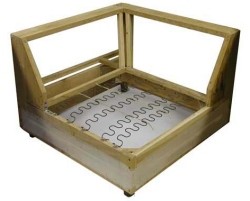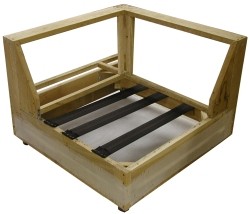When choosing fabrics for upholstered furniture, keep in mind that tightly woven fabrics tend to wear the best. Durability is determined by the number of threads per square inch rather than the thickness of the yarn used. Generally, fabrics that have their pattern woven in will wear better than printed fabrics. For a nice selection of quality fabric, check out mastercraft upholstered furniture. There are many types of fiber used in the manufacturing of upholstered fabrics. They each have unique attributes that must be considered in making a selection based on the planned usage of the upholstered furniture. In addition to their look and feel, factors to consider are wearability, cleanability and sensitivity to direct sunlight. Natural fibers Prized for their soft "hand" and versatility, the natural fibers remain popular as coverings for upholstered furniture.
CottonCotton takes color well (soft and pliable), blends well with other fibers, and is durable with unlimited styling potential. However, continuous exposure to direct sunlight will cause the cotton fiber to disintegrate on your upholstered furniture. In damp climates, cotton may tend to mildew. It is somewhat less stain resistant than synthetics.
Flax/LinenWith a strong, cool, crisp "hand", linen is one of the most durable fibers available for upholstered furniture. It has a tendency to resist color and is often found in natural coloration's as a result. Linen reflects heat somewhat better than cotton, but will disintegrate in intense sunlight. It is at the higher end of fabric cost.
WoolNaturally springy and resilient, wool is extremely durable for upholstered furniture. It tends to take color softly and has good resistance to abrasion. Wool has natural stain resistance, but should be mothproofed before using.
SilkWithout question the most beautiful, yet fragile, of all upholstered furniture fabrics. Soft and lustrous, strong light will tend to discolor and disintegrate the fiber. Difficult to clean, the fibers will tend to mildew in damp climates.
Rayon/AcetateMade of processed cellulose, it can be woven to emulate silk or linen. Its low cost and blendability with other more expensive fibers make it a popular choice for upholstered furniture. The fiber is reasonably colorfast and abrasion resistant, but will tend to rot under long exposure to direct sunlight.
Synthetic fibersThese petroleum-based fibers have been developed over the last sixty years as an alternative to natural fibers and are often blended with them in an effort to achieve the best properties of each in upholstered furniture.
Polyester: a polymer that takes vibrant colors well. Polyester is strong and cleanable and stands up well under direct sunlight. Flame and abrasion resistant, this upholstered furniture fabric is often blended with natural fibers to soften its feel. Recent developments have led to a finely extruded polyester fiber that resembles the look and feel of silk.
Olefin: known by many people by the trade name, Herculon. Strong, with natural stain resistant properties, olefin is a bulky fiber with a coarse "hand" that does not hold up well to direct sunlight. Often it is used to create heavy textured causal fabrics in upholstered furniture. These fabrics when loosely woven require a latex backing for added strength.
Nylon: The strongest and most dirt resistant fiber, nylon is used often in commercial applications where it will take a beating. Until recently, nylon upholstered furniture typically had a high luster. However, now it is often available with a delustered wool look and feel. Its only drawback is its sensitivity to sunlight.
(Source: About.com)






















 If you have older windows and are not ready or cannot replace them, energy efficient window treatments may be your answer to savings. Some carefully selected window treatments can reduce heat loss in the winter and heat gain in the summer.
If you have older windows and are not ready or cannot replace them, energy efficient window treatments may be your answer to savings. Some carefully selected window treatments can reduce heat loss in the winter and heat gain in the summer. Combining several kinds of energy saving coverings such as draperies or cornices with blinds, shades or shutters help you get the most energy efficient solution possible.
Combining several kinds of energy saving coverings such as draperies or cornices with blinds, shades or shutters help you get the most energy efficient solution possible.  At this price you usually get plastic legs screwed into the frame instead of wooden legs that are part of the posts or bolted into the frame, a webbed seating support system with no springs, low-density-foam cushions that will break down quickly under normal wear and tear, inexpensive single-color fabrics, or inexpensive prints where the pattern is machine-stamped on--not woven into the fabric, cheap zippers on the cushions…and you’re lucky if you will get five years of use out of this sofa before it looks pretty bad. The cushions fill will start to fail after about 1 year of normal wear and tear, so considering a $2,500 sofa will last 5-7 years, you just wasted a lot of money.
At this price you usually get plastic legs screwed into the frame instead of wooden legs that are part of the posts or bolted into the frame, a webbed seating support system with no springs, low-density-foam cushions that will break down quickly under normal wear and tear, inexpensive single-color fabrics, or inexpensive prints where the pattern is machine-stamped on--not woven into the fabric, cheap zippers on the cushions…and you’re lucky if you will get five years of use out of this sofa before it looks pretty bad. The cushions fill will start to fail after about 1 year of normal wear and tear, so considering a $2,500 sofa will last 5-7 years, you just wasted a lot of money.

 corner blocks with both staples and screws.
corner blocks with both staples and screws. 
 Some manufacturers claim that steel sinuous wire spring systems are equal, but look at the difference in construction, and then you decide.
Some manufacturers claim that steel sinuous wire spring systems are equal, but look at the difference in construction, and then you decide. 




 “Eco-Friendly” Cushion – Look for cushions that combine a soy-based foam core with a mixed down and feather fill around the center cushion, and covered in a down-proof cotton cover.
“Eco-Friendly” Cushion – Look for cushions that combine a soy-based foam core with a mixed down and feather fill around the center cushion, and covered in a down-proof cotton cover.

 This is a sofa without loose back cushions. The frame is padded with polyurethane and a layer of fiber or down fill and attached for the frame. This is a very neat and contemporary look. It’s a great choice for a guest bedroom sofa-bed where it’s always a question where to throw all the cushions to open up the bed!
This is a sofa without loose back cushions. The frame is padded with polyurethane and a layer of fiber or down fill and attached for the frame. This is a very neat and contemporary look. It’s a great choice for a guest bedroom sofa-bed where it’s always a question where to throw all the cushions to open up the bed!